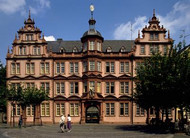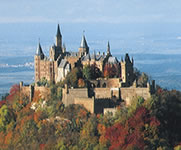Other highlights
Contact
Touristik Centrale Mainz e.V.
Brückenturm am Rathaus
55116 Mainz
Email:
tourist@info-mainz.de
Internet:
www.mainz.de
Brückenturm am Rathaus
55116 Mainz
Email:
tourist@info-mainz.de
Internet:
www.mainz.de
Museums

Situated in the old quarter of Mainz, the Gutenberg Museum is one of the oldest printing museums, attracting tourists and professionals from all over the world. It was founded in 1900, on the 500th anniversary of the birth of Johannes Gutenberg, and is dedicated to the life and work of Gutenberg, the inventor of the printing press. In this printing treasure trove, visitors can explore various sections on printing technology, book design, job printing and bookplates, graphics and posters, paper, type history and modern art books to gain a comprehensive insight into the history of type and printing. The museum's highlights include the famous Gutenberg bible, which is one of the most beautiful printed books in the world. Closed on Mondays and Fridays, multilingual guided tours on request.
» www.gutenberg-museum.de
The middle of the 19th century was a turning point in the history of sekt in Germany. In 1850, on the site of a former Roman military camp in Mainz, Christian Adalbert Kupferberg founded the Kupferberg sekt winery. A visit to the Kupferberg Museum takes you on a journey through 150 years of sekt-making. The fermenting rooms, which still store a number of older bottles, are found deep underground, and there are some beautifully decorated barrels on show in the historical cellar. A particular highlight is the Schützenfass, made in 1894 in celebration of the shooting festival. The museum is also home to the world's largest exhibition of international sekt and champagne glasses. Showcasing the creative genius of artists working in the medium of glass, the collection features more than 500 glasses down the ages – from the Venetian 'Cristallo' of the Renaissance to the trendy designs of the present day. The museum's Traubensaal room, a masterpiece of art nouveau, is also well worth seeing. At the 1900 World's Fair in Paris, it was used as an exhibition hall to promote fine German wines. Closed on Sundays, guided tours available.
» www.kupferbergterrasse.de
Situated in the church of the former Reichklara Abbey, the Natural History Museum in Mainz was opened to visitors back in 1910 and is now the largest and most important museum of its kind in the Rhineland-Palatinate. Few other natural science museums in the world have such an extensive collection of prehistoric dinosaur tracks and insects from the Permian period on the Rhine. With more than 25,000 finds, it has a rich and varied collection of ice-age animals such as the hippo, steppe mammoth, elk, wolf, Javan rhino, giant lion, jaguar, sabre-toothed cat and the famous group of quaggas that all lived in the Rhine-Main region approx. 500,000 years ago. This extensive exhibition is guaranteed to hold your interest like no other. Closed on Mondays.
» www.staff.uni-mainz.de
The Cathedral and Diocesan Museum is located in the Cathedral's two-storey, late-Gothic cloister and in the former chapter house. With more than 3,000m² of exhibition space, it is the second-largest museum of its kind in Germany – presenting works of art from over two millennia. For many centuries, Mainz cathedral treasury ranked among the finest in the Western world. Produced between the 14th and the 18th century, the surviving inventories describe a wealth of liturgical instruments and paraments. The treasury prospered under Archbishops Willigis (975-1011) and Peter von Aspelt (1306-1320). Cardinal Albrecht von Brandenburg (1514-1545), who brought the "Halle'sche Heiltum" reliquaries from Halle to Mainz during the Reformation, also added another 300 items of the most exquisite quality. Closed on Mondays and religious holidays.
» www.dommuseum-mainz.de
The Museum of Ancient Shipbuilding opened its doors in Mainz in 1994. In a collection unparalleled in Germany, the museum presents the original remains of five ships dating back to the late Graeco-Roman period. Known as the "Roman ships of Mainz", their construction differed from mediterranean shipbuilding at the time, demonstrating a technical advancement that allowed standardised production. The ships on display represent the last in a long tradition of ancient shipbuilding. Archaeological evidence shows that part of the Rhine fleet was stationed in Mongontiacum (the Latin name for Mainz) soon after a Roman camp was established around 12 or 13 BC. Don't miss the chance to watch museum staff at work as they recreate models of the ancient vessels. Closed on Mondays.
» www.mainz.de
Travel Planner
Select an option...
Map of Germany
Hotels in Mainz
Loading



